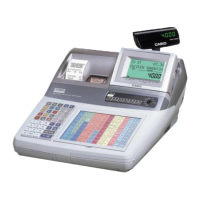
Do you have a question about the Casio TE-4000F Series and is the answer not in the manual?
| Brand | Casio |
|---|---|
| Model | TE-4000F Series |
| Category | Cash Register |
| Language | English |
Procedures for safe handling during malfunctions or damage.
Instructions for safe connection of power plug and AC outlet.
Instructions for installing receipt and journal paper.
Detailed steps for installing receipt paper.
Detailed steps for installing journal paper.
General procedure for operating the cash register daily.
Details on assigning clerks via buttons, keys, or secret numbers.
Setting unit prices and tax statuses for keys.
Steps for programming PLUs, including unit price and tax status.
Setting rates and applying discounts to items or subtotals.
Setting amounts and applying reductions to items.
Processing returns using RF and REG modes.
Correcting items before they are registered.
Correcting registered items.
Cancelling an entire transaction.
Cancelling transactions and performing no-sale operations.
Generating a report of daily sales totals and resetting data.
Checking inventory levels against minimum quantities.
Allowing clerks to interrupt and resume transactions.
Finalizing cash sales immediately after registration.
Applying percentage-based premiums to items or subtotals.
Programming a default tender amount.
Registering and using set menus.
Procedures for handling foreign currency.
Registering food stamp payments and scenarios.
Scenarios for mixed EBT card transactions.
Overview of the check tracking system.
Using the new/old check key for check management.
Recalling and displaying current stock quantities for PLUs.
Recalling and displaying unit prices for departments, PLUs, etc.
Correcting previously registered items using the review function.
Registering items via scanner, code, or NLU key.
Procedures for PLUs not found in the file.
Setting receipt messages, machine numbers, and clerk names.
Assigning descriptors to department and transaction keys.
Assigning descriptors to flat-PLU keys.
Inputting characters via the keyboard layout.
Inputting characters using their numerical codes.
Identifying and resolving error codes.
Detailed list of error codes and their meanings/actions.
Troubleshooting steps when the register is unresponsive.
Procedure to unlock the register after an operational mistake.
How the register behaves and data is protected during power outages.
